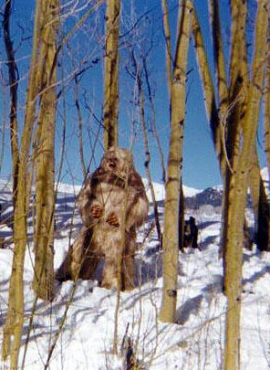| |
 |
The words "yeti" and "abominable snowman" are applied to several types of hairy humanoids similar to North America's Bigfoot, but these creatures are distinct from Bigfoot because they are reported from a different continent altogether.
 |
The most picky cryptozoologists refer to each individual type of yeti by its own native name, dzu-teh for the biggest, hulking giants who sometimes walk on all fours and seem half bear, half ape, meh-teh for the "classic" yeti that stands about six feet tall and has a pointed top of the head, and teh-lma for the three-foot-tall frog-eating yeti that makes its home in steamy jungle valleys between mountains (sometimes thought to be a juvenile yeti by researchers).
The teh-lma is the most human-like of the yetis and is thought to be a race of primitive humans by some researchers, compared to the proto-pygmies. It is also the most ignored of the yetis. Very little research has been focused on it recently, although several decades ago, when it was lumped in with the meh-teh more often than not, this little yeti was more in the spotlight.
The dzu-teh is thought by many researchers to be a bear. It has claws and carnivorous habits, in addition to its bear-like appearance.
 |
Even though it has long, shaggy hair, it is actually supposed to be a valley-dweller, like all other varieties of yeti. The snow-capped peaks don't contain enough food for such a creature to live there, but it is said the meh-teh often has to go through high mountain passes to travel from one valley to another, where it becomes highly visible to human observers and sightings are most likely to take place. In its forested, remote valleys, it is supposed to be nearly impossible to locate, living in a remote territory much like the panda, which eluded researchers for sixty years after its discovery.
Even though the yeti (at least the meh-teh) is one of the best documented of the hairy humanoids, it is also one of the most disputed. Native folklore has heavily obscured whatever real animal or animals that might possibly exist behind the mythology.
According to legend, the yeti is a spiritual being, not an animal. It is sometimes worshipped, attributed with many supernatural powers, and is said to interbreed with humans.
In addition, some legends say that there is no actual breeding population of yetis. Instead, each yeti is actually the transmogrified quasi-solid ghost of a dead human.
Other local mythology states that the yetis are actually demons that have been assigned to guard mountains, so that humans do not ascend to the peaks and disturb the gods who live there. If this is true, then the yetis have failed miserably in their task to keep people from climbing Mt. Everest.
With western observers involved, the picture can get clouded too. The yeti has been shown to be confused with actual humans, bears and even suggestive-looking rocks on some occasions.
In popular culture, the picture gets even more confusing, with the label "yeti" being applied haphazrdly to any Bigfoot-like creature anywhere in the world, even though it should technically apply only to those creatures reported from Himalaya Mountains of Tibet and Nepal, or at the very least to those from Asia.
| You can find out more about the Yeti from the following sources: |
Clark, Jerome and Coleman, Loren. Cryptozoology A-Z. New York: Simon & Schuster, 1999. Pages 23-24, 193-195, 224-226, 233-234
Clark, Jerome. Unexplained!. Detroit: Visible Ink Press, 1999. Pages 378-387, 599-600
Coleman, Jerry D. Strange Highways: A Guidebook to American Mysteries & the Unexplained. Alton, Illinois: Whitechapel Productions Press, 2003. Pages 9, 20
Coleman, Loren. The Field Guide to Bigfoot, Yeti and Other Mystery Primates Worldwide New York: Avon Books, 1999.
Coleman, Loren. Mysterious America: The Revised Edition. New York: Paraview Press, 2001. Page 221
Coleman, Loren. Tom Slick and the Search for the Yeti. Boston: Faber and Faber, 1989.
Cremo, Michael A. & Thompson, Richard L. Living Ape-Men: Yeti: Wildmen of the Himalayas
Gale, Thomson. The Real Manimal?
Hall, Jamie. Bigfoot & Pals
Hall, Mark A. The Yeti, Bigfoot & True Giants.
Innes, Brian. Giant Humanlike Beasts
Keel, John A. The Complete Guide to Mysterious Beings. New York: Doubleday, 1994. Pages 62-64, 66-75
Meldrum, D. Jeffrey. Evaluation of Alleged Sasquatch Footprints and their Inferred Functional Morphology
Meldrum, D. Jeffrey. Hominoid Bipedalism & Cryptozoology
Messner, Reinhold. My Quest for the Yeti: Confronting the Himalayas' Deepest Mystery
http://www.newanimal.org/yeti.htm
Tidak ada komentar:
Posting Komentar